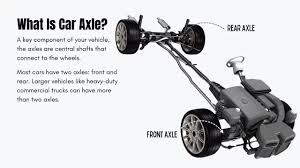
When it comes to the safe and efficient operation of your vehicle, the suspension system plays a crucial role. Among its many components, wheel bearings and CV hubs (constant velocity hubs) are two essential elements that contribute significantly to the performance, safety, and longevity of your vehicle. Understanding their functions and maintenance requirements is vital for any car owner.
What Are Wheel Bearings?
Wheel bearings are precision-made components that allow the wheels to rotate smoothly. They consist of a set of steel balls or rollers encased in a metal ring. These bearings are located between the wheel and the axle, allowing the wheel to spin freely while supporting the weight of the vehicle. In essence, they reduce friction between the moving parts and enable smooth wheel rotation.
There are different types of wheel bearings, including single-row and double-row designs. The type used depends on the vehicle’s design and the loads it must handle. Over time, wheel bearings can wear out due to various factors, including exposure to moisture, dirt, and heat. Signs of failing wheel bearings may include unusual noises, vibrations, or uneven tire wear. If not addressed promptly, a worn-out wheel bearing can lead to more severe issues, including complete wheel failure.
The Role of CV Hubs
Constant velocity hubs, commonly referred to as CV hubs, are an integral part of a vehicle’s drivetrain. These hubs connect the transmission to the wheels, allowing for smooth power transfer while accommodating the up-and-down motion of the suspension. CV hubs house CV joints, which enable the driveshaft to transmit power at varying angles while maintaining a constant speed. This is especially important in front-wheel-drive vehicles and those with independent rear suspension systems.
CV hubs come in two main types: inner CV joints and outer CV joints. The inner joints connect to the transmission, while the outer joints connect to the wheel hub assembly. A properly functioning CV hub ensures that your vehicle can navigate turns and uneven terrain without losing power or control. However, like wheel bearings, CV hubs can wear out over time, leading to issues such as clicking or popping noises when turning or a loss of power to the wheels.
Maintenance and Care
Regular maintenance of wheel bearings and CV hubs is essential for ensuring your vehicle’s performance and safety. Here are some key maintenance tips:
- Regular Inspections: During routine vehicle maintenance, mechanics should inspect the wheel bearings and CV hubs for signs of wear or damage. This is particularly important if you notice any unusual noises or handling issues.
- Proper Lubrication: Wheel bearings require proper lubrication to function effectively. Check the bearing seals for leaks and ensure they are properly lubricated to prevent overheating and premature wear.
- Addressing Issues Promptly: If you notice signs of wear, such as noises or vibrations, address these issues promptly. Ignoring them can lead to more extensive and expensive repairs down the line.
- Alignment and Balancing: Regular wheel alignment and balancing can help prolong the life of your wheel bearings and CV hubs by ensuring even weight distribution and reducing stress on these components.
Conclusion
In summary, wheel bearings and CV hubs are critical components of your vehicle’s suspension and drivetrain systems. Understanding their functions and recognizing the signs of wear can help you maintain your vehicle’s performance and safety. By staying proactive with maintenance and addressing issues promptly, you can ensure that your vehicle operates smoothly and efficiently for years to come.
Click the button below to find out more!

